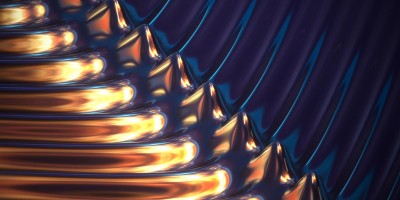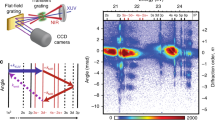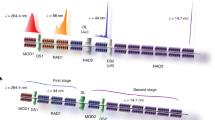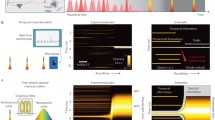Abstract
The quantum cascade laser has evolved to be a compact, powerful source of coherent mid-infrared light; however, its fast gain dynamics strongly restricts the formation of ultrashort pulses. As such, the shortest pulses reported so far were limited to a few picoseconds with some hundreds of milliwatts of peak power, strongly narrowing their applicability for time-resolved and nonlinear experiments. Here we demonstrate an approach capable of producing near-transform-limited subpicosecond pulses with several watts of peak power. Starting from a frequency-modulated phase-locked state, ultrashort high-peak-power pulses are generated via spectral filtering, gain modulation-induced spectral broadening and external pulse compression. We assess their temporal nature by means of a novel asynchronous sampling method, coherent beat note interferometry and interferometric autocorrelation. These results open new pathways for nonlinear physics in the mid-infrared.






Similar content being viewed by others
Data availability
The measurement data that support the plots within this paper are available at https://www.research-collection.ethz.ch/handle/20.500.11850/504681 and from the corresponding author on reasonable request. Data that support the findings in this article are also available in the ETH Research Collection43.
Code availability
The analysis codes will be made available on reasonable request.
Change history
24 November 2021
In the HTML version of this Article published online, the copyright information was in error; the copyright information has now been corrected.
References
Haus, H. A. Mode-locking of lasers. IEEE J. Sel. Top. Quantum Electronics 6, 1173–1185 (2000).
Morgner, U. et al. Sub-two-cycle pulses from a Kerr-lens mode-locked Ti:sapphire laser. Opt. Lett. 24, 411–413 (1999).
Sutter, D. H. et al. Semiconductor saturable-absorber mirror-assisted Kerr-lens mode-locked Ti:sapphire laser producing pulses in the two-cycle regime. Opt. Lett. 24, 631–633 (1999).
Huber, R. et al. How many-particle interactions develop after ultrafast excitation of an electron-hole plasma. Nature 414, 286–289 (2001).
Torre, R., Bartolini, P. & Righini, R. Structural relaxation in supercooled water by time-resolved spectroscopy. Nature 428, 296–299 (2004).
Udem, T., Holzwarth, R. & Hänsch, T. W. Optical frequency metrology. Nature 416, 233–237 (2002).
Pires, H., Baudisch, M., Sanchez, D., Hemmer, M. & Biegert, J. Ultrashort pulse generation in the mid-IR. Prog. Quantum Electron. 43, 1–30 (2015).
Cao, Q., Kärtner, F. X. & Chang, G. Towards high power longwave mid-IR frequency combs: power scalability of high repetition-rate difference-frequency generation. Opt. Express 28, 1369–1384 (2020).
Faist, J. et al. Quantum cascade laser. Science 264, 553–556 (1994).
Jouy, P. et al. Dual comb operation of λ ~ 8.2 μm quantum cascade laser frequency comb with 1 W optical power. Appl. Phys. Lett. 111, 141102 (2017).
Schwarz, B. et al. Watt-level continuous-wave emission from a bifunctional quantum cascade laser/detector. ACS Photon. 4, 1225–1231 (2017).
Hugi, A., Villares, G., Blaser, S., Liu, H. C. & Faist, J. Mid-infrared frequency comb based on a quantum cascade laser. Nature 492, 229–233 (2012).
Singleton, M., Jouy, P., Beck, M. & Faist, J. Evidence of linear chirp in mid-infrared quantum cascade lasers. Optica 5, 948–953 (2018).
Choi, H. et al. Gain recovery dynamics and photon-driven transport in quantum cascade lasers. Phys. Rev. Lett. 100, 167401 (2008).
Wang, C. Y. et al. Mode-locked pulses from mid-infrared quantum cascade lasers. Opt. Express 17, 12929–12943 (2009).
Revin, D. G., Hemingway, M., Wang, Y., Cockburn, J. W. & Belyanin, A. Active mode locking of quantum cascade lasers in an external ring cavity. Nat. Commun. 7, 11440 (2016).
Hillbrand, J. et al. Mode-locked short pulses from an 8 μm wavelength semiconductor laser. Nat. Commun. 11, 5788 (2020).
Barbieri, S. et al. Coherent sampling of active mode-locked terahertz quantum cascade lasers and frequency synthesis. Nat. Photon. 5, 306–313 (2011).
Wang, F. et al. Generating ultrafast pulses of light from quantum cascade lasers. Optica 2, 944–949 (2015).
Wang, F. et al. Short terahertz pulse generation from a dispersion compensated modelocked semiconductor laser. Laser Photon. Rev. 11, 1700013 (2017).
Hillbrand, J., Andrews, A. M., Detz, H., Strasser, G. & Schwarz, B. Coherent injection locking of quantum cascade laser frequency combs. Nat. Photon. 13, 101–104 (2019).
Cappelli, F. et al. Retrieval of phase relation and emission profile of quantum cascade laser frequency combs. Nat. Photon. 13, 562–568 (2019).
Opačak, N. & Schwarz, B. Theory of frequency-modulated combs in lasers with spatial hole burning, dispersion, and Kerr nonlinearity. Phys. Rev. Lett. 123, 243902 (2019).
Burghoff, D. Unraveling the origin of frequency modulated combs using active cavity mean-field theory. Optica 7, 1781–1787 (2020).
Chinn, S. & Swanson, E. Passive FM locking and pulse generation from 980-nm strained-quantum-well Fabry-Perot lasers. IEEE Photon. Technol. Lett. 5, 969–971 (1993).
Sato, K. Optical pulse generation using Fabry-Pe/spl acute/rot lasers under continuous-wave operation. IEEE J. Sel. Top. Quantum Electron. 9, 1288–1293 (2003).
Rosales, R. et al. High performance mode locking characteristics of single section quantum dash lasers. Opt. Express 20, 8649–8657 (2012).
Martinez, O. 3000 Times grating compressor with positive group velocity dispersion: application to fiber compensation in 1.3–1.6 μm region. IEEE J. Quantum Electron. 23, 59–64 (1987).
Singleton, M., Beck, M. & Faist, J. Pulses from a mid-infrared quantum cascade laser frequency comb using an external compressor. J. Opt. Soc. Am. B 36, 1676–1683 (2019).
Gellie, P. et al. Injection-locking of terahertz quantum cascade lasers up to 35 GHz using RF amplitude modulation. Opt. Express 18, 20799–20816 (2010).
Burghoff, D. et al. Terahertz laser frequency combs. Nat. Photon. 8, 462–467 (2014).
Burghoff, D. et al. Evaluating the coherence and time-domain profile of quantum cascade laser frequency combs. Opt. Express 23, 1190–1202 (2015).
Takara, H., Kawanishi, S., Yamabayashi, Y. & Saruwataris, M. An ultrahigh-speed optical waveform measurement method based on optical sampling with sum-frequency generation. Electron. Commun. Jpn 76, 1–11 (1993).
Argence, B. et al. Quantum cascade laser frequency stabilization at the sub-Hz level. Nat. Photon. 9, 456–460 (2015).
Karstad, K. et al. Detection of mid-IR radiation by sum frequency generation for free space optical communication. Optics Lasers Eng. 43, 537–544 (2005).
Rodwell, M. J. W., Weingarten, K. J., Bloom, D. M., Baer, T. & Kolner, B. H. Reduction of timing fluctuations in a mode-locked Nd:YAG laser by electronic feedback. Opt. Lett. 11, 638–640 (1986).
Piccardo, M. et al. Frequency-modulated combs obey a variational principle. Phys. Rev. Lett. 122, 253901 (2019).
Boiko, D. L. et al. Mid-infrared two photon absorption sensitivity of commercial detectors. Appl. Phys. Lett. 111, 171102 (2017).
Kapsalidis, F. et al. Mid-infrared quantum cascade laser frequency combs with a microstrip-like line waveguide geometry. Appl. Phys. Lett. 118, 071101 (2021).
Strickland, D. & Mourou, G. Compression of amplified chirped optical pulses. Opt. Commun. 56, 219–221 (1985).
Benedikovic, D. et al. Dispersion control of silicon nanophotonic waveguides using sub-wavelength grating metamaterials in near- and mid-ir wavelengths. Opt. Express 25, 19468–19478 (2017).
Cai, H., Liu, S., Lalanne, E. & Johnson, A. M. Investigation of giant Kerr nonlinearity in quantum cascade lasers using mid-infrared femtosecond pulses. Appl. Phys. Lett. 106, 051102 (2015).
Täschler, P. ETH Research Collection (ETH, 2021); https://www.research-collection.ethz.ch/handle/20.500.11850/504681
Acknowledgements
This work was supported by the BRIDGE program, funded by the Swiss National Science Foundation and Innosuisse, in the scope of the CombTrace (no. 176584; P.T., M.Bertrand, F.K.) project. Further financial support was provided by the Swiss National Science Foundation (no. 165639; M.S., P.J.) and the European Union’s Horizon 2020 research and innovation program Qombs (no. 820419; B.S.). We would like to gratefully thank J. Hillbrand for helpful advice and discussion while conducting the experiments and for proofreading the manuscript. Moreover, we express gratitude to S. Markmann and A. Forrer for their careful reading of the paper, S. Wang for his preliminary work on ASUPS and R. Wang for providing QCLs in an early stage of the work. We thank E. Gini of the FIRST—Center for Micro- and Nanoscience for the MOVPE regrowths.
Author information
Authors and Affiliations
Contributions
P.T. built the upconversion, SWIFTS and autocorrelation set-up, performed the experiments and wrote the manuscript with editorial input from M.Bertrand, B.S. and J.F. M.Bertrand characterized the normal buried heterostructure device (LIV, optical spectra) used for this publication, performed preliminary IAC experiments and helped with the set-up of the radiofrequency-optimized device. B.S. was involved in the SWIFTS analysis, characterized the radiofrequency-optimized laser (LIV, optical spectra, beat note), helped with its set-up and performed preliminary strong microwave modulation experiments. M.S. dimensioned the grating compressor. P.J. and F.K. processed the QCLs used in this work. M.Beck was responsible for MBE growth. J.F. supervised this work.
Corresponding authors
Ethics declarations
Competing interests
The authors declare no competing interests.
Additional information
Peer review information Nature Photonics thanks Stefano Barbieri, Benedikt Schwarz and the other, anonymous, reviewer(s) for their contribution to the peer review of this work.
Publisher’s note Springer Nature remains neutral with regard to jurisdictional claims in published maps and institutional affiliations.
Supplementary information
Supplementary Information
Supplementary Sections 1–5 and Figs. 1–5.
Rights and permissions
About this article
Cite this article
Täschler, P., Bertrand, M., Schneider, B. et al. Femtosecond pulses from a mid-infrared quantum cascade laser. Nat. Photon. 15, 919–924 (2021). https://doi.org/10.1038/s41566-021-00894-9
Received:
Accepted:
Published:
Issue Date:
DOI: https://doi.org/10.1038/s41566-021-00894-9
- Springer Nature Limited
This article is cited by
-
Active mid-infrared ring resonators
Nature Communications (2024)
-
Nozaki–Bekki solitons in semiconductor lasers
Nature (2024)
-
Coherent control of a high-orbital hole in a semiconductor quantum dot
Nature Nanotechnology (2023)
-
GaAs-chip-based mid-infrared supercontinuum generation
Light: Science & Applications (2023)
-
Mid-infrared ultrashort pulse generation
Nature Photonics (2021)





